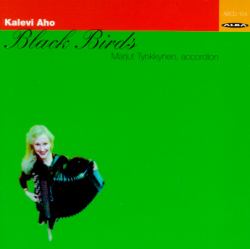The Free-Reed Review
Critiques of Compact Discs, Books and Music Scores
CD Review: Marjut Tynkkynen
Black Birds

total time: 42:30
released: 1994
label: Alba Records Oy
P.O. Box 549
FIN-33101
Tampera
Finland
Tel Int +358-31-345 1387
Fax Int +358-31-345 1384
|
Marjut Tynkkynen, accordion
Program:
Kalevi Aho: Sonata for accordion no. 1
Kalevi Aho: Sonata for accordion no. 2 (Black Birds)
music published by: Modus
Musiikki Oy http://www.sicom.fi/EditionModus/su
PO Box 82
57101 Savonlinna
Finland
Phone 015-510 552
FAX 015-510 553
e-mail:
modusmus@icom.fi
|
Review by Joseph Natoli:
Make no mistake, "Black Birds" is an extremely important recording
for accordionists because it represents some of the most intensely
virtuostic composing and performing ever accomplished on the instrument.
Of course this wonderful contribution will not be appreciated by everyone,
for this is contemporary music of the highest order that makes no
pretensions about wanting to be loved or even understood by the masses.
There are many who will therefore make the argument that such eclectic
music serves no real purpose in art, especially if it can only be
appreciated by a discreet handful of listeners. "It has no market
potential, no charisma," some would say. "It is such difficult music, it
will never be performed beyond this recording," others would say. My
guess is that both the composer and the performer are not concerned with
such proletarian issues. This project obviously emanated from one focused
objective, and that is, from the first note composed to the last note
performed, its intent was to create profoundly artistic music, whether or
not it is embraced immediately by the masses.
Sonata #1 and Sonata #2 (Black Birds) by Kalevi Aho are
absolutely spectacular examples of the best music that exists in
contemporary accordion literature. Even though the accordion world has its
share of incredible virtuosi, the demands on the performer are so extreme
in these two compositions, I had no idea that we even possessed the kind
of virtuosity that exists in these two performances by Marjut Tynkkynen.
Ms. Tynkkynen seems to perform with the technical and rhythmic accuracy of
a computer, but manages to beautifully complement this ability with the
sensitivity of a Vladimir Horowitz, a satisfying combination of traits
which are very uncanny in contemporary music. She must have at least 20
different levels of pianissimo which are just the "tip of the iceberg" in
discovering the kinds of control of which this extremely talented musician
is capable.
Kalevi Aho states in the performance notes that "My purpose in composing
this sonata was to stretch the technical and expressive limits of the
accordion as far as they would go, and to provide the instrument with a
work on a par with the most brilliant piano pieces by Liszt in terms of
virtuosity." It would be more appropriate to compare this work to the
likes of the Eliott Carter Piano Concerti, or Stockhausen Klavierstucke
rather than Liszt. The inclusion of passages with multiple ratios of
tuplets in one hand, huge leaping atonal runs, and two-octave repeated
notes are something that Liszt could only envy and wish that the piano of
his day could accomplish.
Mr. Aho also indicates that the "Sonata #1 was composed for a free bass
accordion with 'studs'—and ingenious manual system that
allows extremely wide spans and figures that cannot be obtained on any
other instrument." I was immediately envious and intimidated by the
possibilities of this unique accordion, especially in the hands of Marjut
Tynkkynen. The gymnastics she accomplishes on this type of instrument are
unparalleled on ANY instrument, bar none. These same pyrotechnics are
again evident in Sonata #2 (Blackbirds), where each of the five movements
is a metaphorical reference to bird song. But to accomplish this metaphor
there are many passages that seek to emulate the random and very quick
wide leaps of bird song. Again, Ms. Tynkkynen executes these "impossible"
passages with ease and grace.
If you cannot tell already, I was extremely moved by this recording.
Granted this music is not easy, but then again nothing worthwhile ever is.
It takes work to grasp the intricacies of these two sonatas, and certainly
every new audition of these pieces will reveal new and interesting levels
of structure and beauty. Therefore, even though this CD is not for the
musically meek of heart, those brave enough to venture into some new
territory will reap copious awards. Personally, I hope to listen to these
pieces many more times in the years to come and cannot wait to hear new
projects from Kalevi Aho or Marjut Tynkkynen. Bravo!
